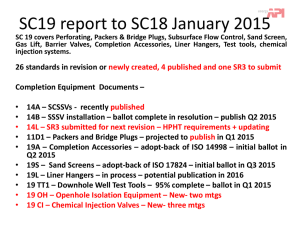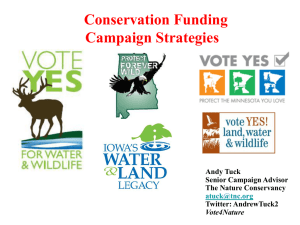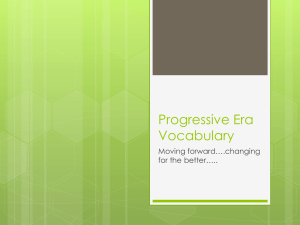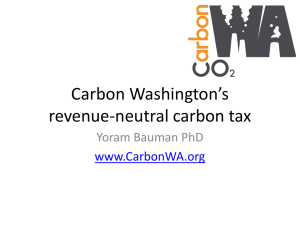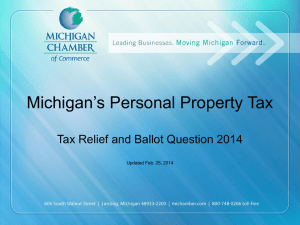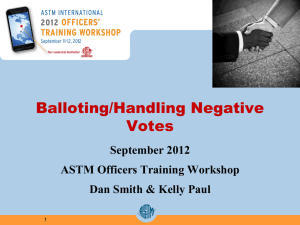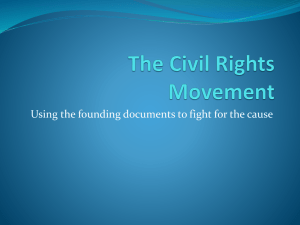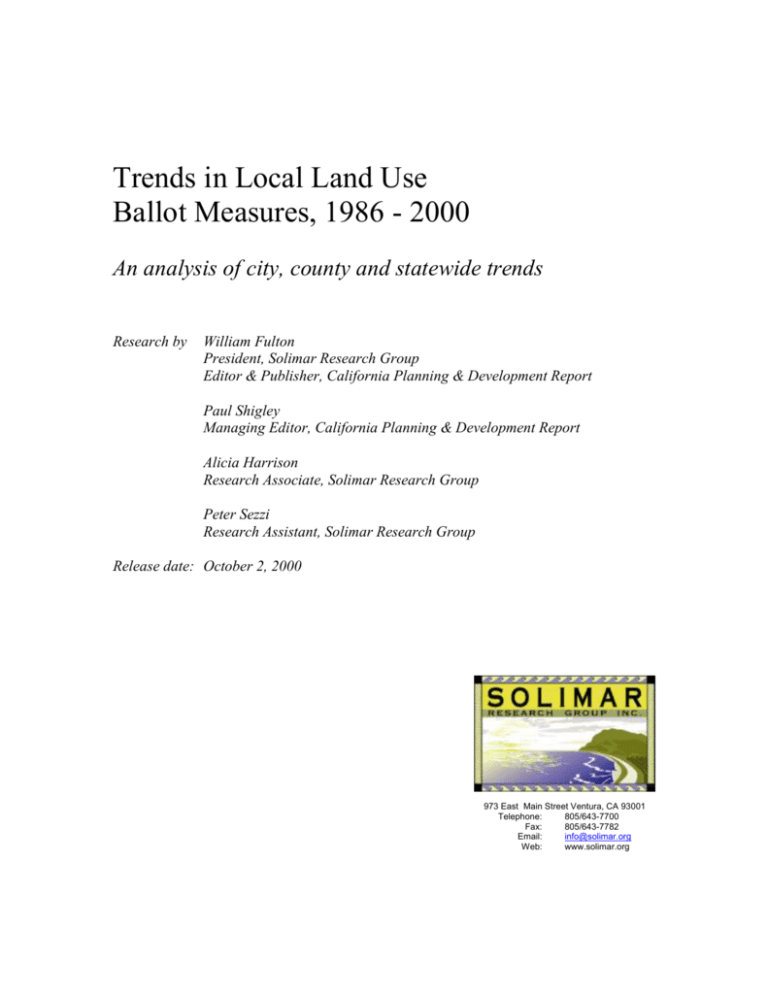
Trends in Local Land Use
Ballot Measures, 1986 - 2000
An analysis of city, county and statewide trends
Research by
William Fulton
President, Solimar Research Group
Editor & Publisher, California Planning & Development Report
Paul Shigley
Managing Editor, California Planning & Development Report
Alicia Harrison
Research Associate, Solimar Research Group
Peter Sezzi
Research Assistant, Solimar Research Group
Release date: October 2, 2000
973 East Main Street Ventura, CA 93001
Telephone:
805/643-7700
Fax:
805/643-7782
Email:
info@solimar.org
Web:
www.solimar.org
I.
INTRODUCTION
Over the last few decades, California has become a showcase for local land use related
ballot measure activity. In fact, over the last 15 years, there were 610 land use ballot
measures, 660 including the November 2000 measures. But while California hosts a
significant amount of land use measure activity, little effort has been put forth to
understand the changing dynamics of local, county and statewide trends.
Collecting information and results for all countywide and local land use ballot measures
from June, November, and selected March ballots between 1986 and 2000, Solimar
Research Group has assembled a local land use ballot measure database. Using this
database, the goal of this report is to gain a better understanding of land use measure
trends throughout California, asking questions like: Have ballot measures migrated over
time? Are they geographically concentrated? Do they mostly promote growth or slow it
down? Our preliminary results are revealed in the following sections.
II.
STATEWIDE RESULTS
Total Ballot Measures
Between 1986 and 2000, we identified 610 land use measures statewide, 660 including
the November 2000 land use measures.
1
Chart 1: Total Ballot Measures By Year, 1986 - 2000
110
100
99
93
90
80
70
67
60
55
54
50
46
43
40
45
39
30
27
20
20
26
19
15
12
10
2000
1999
1998
1997
1996
1995
1994
1993
1992
1991
1990
1989
1988
1987
1986
0
Total Measures
As shown in Chart 1, ballot measure activity has fluctuated significantly throughout the
state over the last 15 years. Activity slowed down during the 1990's period of recession,
but increased again afterward. With 50 land use measures on the November 2000 ballot,
it appears that ballot measure activity is on the rise again in California.
Types of Ballot Measures
Overall, Slow-Growth measures have been more frequent over the 15-year period. Of the
total 660 ballot measures, 225 (34%) of them are Pro-Growth and 383 (58%) are SlowGrowth. Another 52 (8%) are Neutral.
Ballot Measure Results
As shown in Chart 2, Slow-Growth measures passed more frequently than Pro-Growth
measures up through 1993. From 1994 and 1997, however, this pattern shifted, and ProGrowth results either tied or exceeded Slow-Growth results. Historic patterns returned
from 1998 through 1999. Pro-Growth results exceed Slow-Growth results again in 2000,
but this only reflects the March election results. 2000 results may change after the
November election. Overall, 57% of all ballot measure results were Slow-Growth (either
"Slow-Yes" or "Pro-No") and 43% of all ballot measures were Pro-Growth (either "ProYes" or "Slow-No") over the 15-year period.
2
Chart 2: Pro-Growth vs. Slow-Growth Results, 1986 - 2000
60
50
40
30
20
10
Pro-Yes; Slow-No
2000
1999
1998
1997
1996
1995
1994
1993
1992
1991
1990
1989
1988
1987
1986
0
Slow-Yes; Pro-No
3
III.
AGGREGATE OF CITY AND COUNTYWIDE RESULTS
Total Ballot Measures
Overall, the most ballot measure activity (measured as the aggregate of city and
countywide measures) has historically been concentrated in counties in the Bay Area,
Metropolitan Los Angeles, and San Diego County. Over the 15-year period, San Diego
County (80 ballot measures) had the most ballot measures over the 15-year period, almost
20 more than the second highest county, Los Angeles County (64 ballot measures).
4
Types of Ballot Measures
By aggregating county totals into regions, we are able to identify regional differences in
ballot measure activity. As Chart 3 shows, Slow-Growth measures represent the most
measures in all regions except for the Central Valley and the North Coast region. In
Southern California, Slow-Growth measures represent more than double the number of
Pro-Growth measures. In the San Diego region, however, Pro-Growth and Slow-Growth
measure totals are similar.
Chart 3: Total Ballot Measures by Region, 1986 - 2000
140
120
100
80
Pro-Growth
Slow-Growth
60
40
20
0
Southern
California
San Diego
Central Coast Central Valley
Upper
Sacramento/
Mountain
Counties
North Coast
San
Francisco
Bay Area
5
Ballot Measure Results
A majority of the regions had Slow-Growth results between 1986 and 2000. The
exceptions were the North Coast region, the Upper Sacramento/Mountain Counties
region, and San Diego County, as shown in Chart 4.
Chart 4: Pro-Growth and Slow-Growth Results
By Region, 1986 - 2000
120
100
80
Pro-Yes; Slow-No
Slow-Yes; Pro-No
60
40
20
0
Southern
California
San Diego
Central Coast Central Valley
Upper
Sacramento/
Mountain
Counties
North Coast
San
Francisco
Bay Area
6
IV.
RESULTS BY CITY
By mapping ballot measures by city over time (does not include countywide measures),
we were able to identify the changing patterns and migration of ballot measures
throughout the state. Overall results indicate that from 1986 through 2000 ballot measure
activity has:
Concentrated in the Los Angeles Metropolitan Area, Bay Area, and San Diego
County;
Occurred closer to coastal areas than inland regions;
Located near older cities;
Spread out more in Southern California compared with the Bay Area.
7
Total Ballot Measures By City
In the Bay Area region, ballot measure activity is primarily concentrated in the East and
South Bay counties, with varying concentrations over the 15-year period. Over the last
four years, however, ballot measure activity has increasingly extended into more North
Bay counties. Overall, there seems to be a tighter concentration of ballot activity in the
Bay Area compared to Southern California.
In the Southern California region, activity started out more closely concentrated around
Los Angeles County between 1986 and 1990, but then pushed out significantly,
especially between 1991 and 1995. More distant localities in Ventura, Riverside and San
Bernardino Counties began to experience more ballot measure activity during this time,
which has continued into recent years.
By city, the highest concentrations of ballot measure activity do not seem to follow a
geographical pattern, as shown in Table 1. Many of the different state's regions, coastal
and inland, are represented. As expected, however, from 1986 through 2000, San
Francisco and San Diego experienced the most ballot measure activity.
Table 1: Cities with the Most Ballot Measures, 1986 - 2000
City
San Francisco
San Diego
Hermosa Beach
Lodi
Pleasanton
Escondido
Simi Valley
Modesto
Morro Bay
Pacifica
County
San Francisco
San Diego
Los Angeles
San Joaquin
Alameda
San Diego
Ventura
Stanislaus
San Luis Obispo
San Mateo
Total
Measures*
26
22
17
16
11
10
9
8
8
8
Total
Pro
13
14
6
16
0
8
3
7
4
7
Total
Total
Slow
Neutral
10
3
7
1
11
0
0
0
11
0
2
0
6
0
1
0
4
0
1
0
* Total includes November 2000 ballot measures.
Overall, ballot measure activity has decreased by nearly half in the Southern California
area, from 93 ballot measures from 1986 through 1990 to 48 ballot measures from 1996
through November 2000. Activity in the Bay Area region has also decreased, but not by
nearly as much — from 99 ballot measures from 1986 through 1990 to a total of 86 from
1996 through 2000.
8
Types of Ballot Measures
Over the 15-year period, Slow-Growth measures have been more concentrated in the
coastal communities of the South Bay and East Bay region of the Bay Area. Pro-Growth
measures are generally more spread out geographically.
From 1986 through 1990, communities in Contra Costa, Alameda and Santa Clara
counties saw a significant number of Slow-Growth measures. The period from 1991
through 1995 followed the same pattern, but with much less activity. From 1996 through
2000, however, ballot measure activity, particularly Slow-Growth measures, moved
outward to the North Bay region, especially Sonoma County.
In the Southern California area from 1986 through 1990, Slow-Growth measures have
primarily concentrated in the coastal communities in Orange and San Diego Counties, as
well as coastal and inland counties in Los Angeles County. Pro-Growth measures mostly
concentrated in Los Angeles and San Diego Counties.
However, from 1991 through 1995 ballot measure activity began to spread. More and
more measures occurred farther away from coastal cities, and during this period they
were primarily Pro-Growth. This trend continued through 1996 to 2000, with more
distant counties such as Ventura and San Bernardino showing increased activity,
particularly Slow-Growth measures.
Ballot Measure Results
In the Bay Area, both Slow-Growth and Pro-Growth results concentrated in the coastal
communities. Overall, Pro-Growth results were more geographically dispersed in the East
Bay and South Bay and Slow-Growth results were more geographically dispersed in the
North Bay.
Overall, 41% of all measures in the Bay Area region were passed to promote growth,
while 59% were passed to slow growth down.
In Southern California, overall Slow-Growth results were more concentrated in coastal
communities and inland Los Angeles County cities. Overall Pro-Growth results were
more geographically dispersed.
Overall, nearly 43% of all measures in the Southern California region were passed to
promote growth, while 57% were passed to slow growth down. This shows a higher ProGrowth passage rate and a lower Slow-Growth passage rate for Southern California than
in the Bay Area.
9
V.
COUNTYWIDE RESULTS
Total Ballot Measures
Countywide measures (does not include city ballot measures) are also concentrated in the
Bay Area and Metropolitan Los Angeles regions, but they are much more frequent in
counties along the Central Coast and in the Central Valley. Overall, the most ballot
measure activity was from 1986 through 1990 and 1996 through 2000, when activity
concentrated primarily in the Central Coast and Bay Area counties.
10
Types of Ballot Measures
Similar to the ballot measure description by city, countywide Slow-Growth measures are
more concentrated in coastal counties, and countywide Pro-Growth measures are more
geographically diverse. Pro-Growth measures are primarily concentrated in the Central
Coast counties, but also extend into the North Coast, upper Central Valley, and North
Bay Area counties. Slow-Growth measures are mostly concentrated in the coastal
counties throughout the state: the Central Coast, Los Angeles Metropolitan Area, as well
as San Diego County. Slow-Growth measures are present in both the North and South
Bay regions of the Bay Area.
Ballot Measure Results
Overall countywide Pro-Growth results (over 50% passage) are primarily concentrated in
the Upper Sacramento and Mountain Counties regions. And in Central and Southern
California, Pro-Growth results occurred in Santa Barbara, Orange and Riverside counties.
However, most counties show less than a 50% passage rate for Pro-Growth measures.
Overall countywide Slow-Growth results (over 50% passage) are concentrated in the
Central and Southern California coastal counties of Los Angeles, Ventura, San Luis
Obispo and Monterey counties. Slow-Growth results are also concentrated in the South
Bay and North Bay Areas of the San Francisco Bay Area region.
VI.
CONCLUSION
By aggregating and mapping ballot measure totals, types, and results for California cities
and counties over the last 15 years, we have begun to identify trends in local land use
measures. Overall, our findings reveal the following:
During our 15-year study period, there have been substantially more Slow-Growth
measures on the ballot than Pro-Growth measures.
Counting the results of all measures, the electorate has voted to limit growth 57% of
the time.
Although the total number of local land use ballot measures has decreased since the
high period of 1986 through 1990, ballot measures activity is on the rise again —
especially this year. The San Francisco Bay Area has experienced substantial ballot
measure activity since 1996.
Ballot measure activity appears to correspond with periods of economic recession and
prosperity in California. Ballot measure activity was greatest during the boom years
of 1986 through 1990, subsided during the recession period of 1991 through 1995,
and picked up as the economy strengthened from 1996 through 2000. Voters appear
more willing to limit urban growth during times of economic prosperity.
11
However, ballot results have not followed the same trend. Slow-Growth ballot
victories have declined over time. From 1986 through 1990, the Slow-Growth
position won 60% of the time. This figure dropped to 56% from 1991 through 1995,
and it dropped further to only 50% from 1996 through March of 2000. This drop has
occurred mostly because Pro-Growth measures have passed more often, not because
Slow-Growth measures have failed more often.
Overall, ballot measure activity in Southern California decreased by approximately
half during our 15-year study period. The number of ballot measures also decreased
in the Bay Area, but not as sharply as in the southern part of the state.
City and countywide measures have been most common in urban coastal areas, and
there has been minimal migration of land use ballot measures to other regions. In the
Bay Area, ballot measures have historically concentrated in the East Bay and South
Bay; however, activity has spread to the North Bay since 1996. In Southern
California, ballot measure activity that was concentrated in Los Angeles and Orange
counties during the 1986 to 1990 period has spread to Ventura and San Bernardino
counties.
San Diego and Los Angeles counties had the most ballot measures (when counting
both city and countywide measures). Those two counties have accounted for nearly
22% of all local land use ballot measures in the state since 1986. The cities of San
Francisco and San Diego had more land use ballot measures than any other cities.
Contra Costa and San Luis Obispo counties had the most countywide ballot measures.
Thirty-seven Urban Growth Boundary/SOAR-like measures have appeared on local
ballots around the state since 1986, including 11 on the ballot in November of 2000.
Of the 25 legitimate measures that appeared between 1990 and March 2000, only one
failed. Twenty of the 37 measures have appeared in just two counties, Ventura and
Sonoma. Six more have appeared in Alameda County.
Through varying degrees of ballot measure activity at the city, county and regional level,
local land use measures are shown to have dynamic trends over time. The trends are not
only interesting, but help to paint the "big picture" of ballot-box land use planning in
California.
12
Copyright © 2000 Solimar Research Group Inc.
All rights reserved.
This publication or any information contained herein may not be reproduced in any form without the express written consent of
Solimar Research Group Inc.

